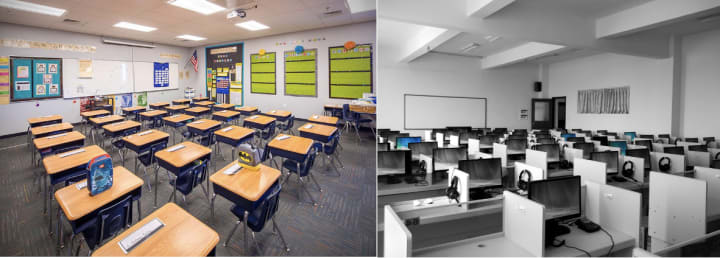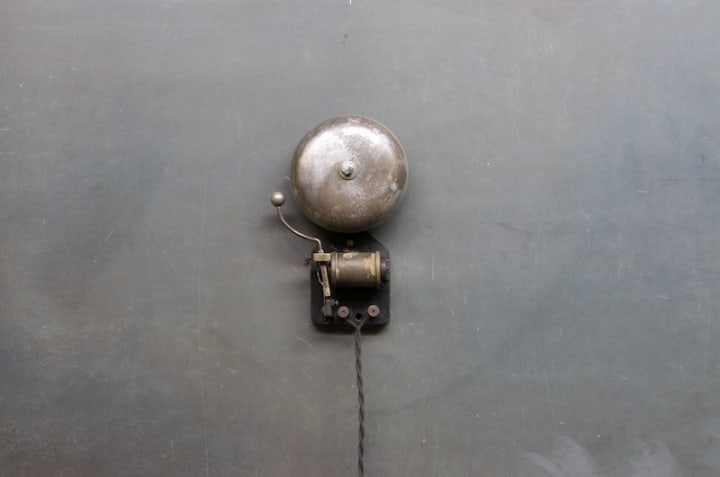FYI: Modern Classroom Design Mirrors Factory Design During the Industrial Revolution
Four ways that our education still reflects factory workers, conveyor belts, and product, product, product.

If I tell you to imagine a classroom, we all probably imagine roughly the same thing: rows of desk all facing the front of the room, a chalkboard or whiteboard at the front where the teacher stands, perhaps a bell on the wall that rings when class is over. Well, I recently learned that all of these characteristics stem from none other than factories during the Industrial Revolution. That’s right! For your information, we’ve all basically been educated in a factory.
Public education became a more homogenized, widespread phenomenon during the Industrial Revolution. Before then, schools existed, but were sparse, private, and not free—meaning that most kids couldn’t afford to be educated.
But with the Industrial Revolution came many changes to the economy and to society. Suddenly, people realized the importance of education for all kids, and they established the public school system we know today. That said, during this time of great industrial change, the overarching values of society were productivity and efficiency. Factories were designed with these principles in mind so that workers could create products as quickly and efficiently as possible.
And schools… well, schools were being designed with these same principles in mind. Increase productivity. Increase efficiency. Decrease personalization.
Okay, let’s break this down.
One : Desks in a Row
So, the most obvious feature shared by the factory and the classroom are the rows of desk facing forward toward some authority figure at the front of the room. In factories, these workstations made the product-making process more efficient by giving everyone a clear space in which to work. In classrooms, desks perform a similar role for students. Everyone sits down at their pre-assigned seat and cranks out tests and assignments.
To me, looking at the images side-by-side really casts an austere hue over the classroom. Am I the only one here??


In addition, having an authority figure in the front of the factory allowed this person to discipline out-of-line workers. Similarly, the teacher is able to do so from their typical perch at the front of the classroom. This particular design feature also signals a top-down knowledge transfer from authority figure to subordinates. For example, the factory boss knows more than the workers, and thus tells the workers what to do; the workers don’t have the freedom to explore different ways of working. The teacher knows more than the students, and thus tells the students what to do; the students don’t have the freedom to explore different ways of learning.
Big yike, am I right?
Two : The Ringing of the Bell
Another shared design feature is the use of a bell to signal the end of shifts or classes. In my experience, my elementary school used a bell to signal the beginning of the day, lunchtime, and the end of the day. In middle and high school, it was used to signal the beginning and end of each class.
Ever wonder why a bell is used? Well, this practice actually originated in the factories, where bells were used to signal the beginning and end of each shift, as well as lunchtime. Still today, both factories and schools use the same bells.

The most interesting thing is, before the Industrial Revolution, most people didn’t even own clocks. They just kind of… relied on the sun still, but they also didn’t worry about chopping the day up into specific timed segments. That changed during the Industrial Revolution when people had to be at the factories at specific times, and when the ringing of the bells taught workers to segment their days by the hour.
Today, we probably can’t imagine not keeping track of the time. Counting down the hours in a school day is practically second nature. Yet still today, even in school, we have the mentality of “work v. leisure” time. School is considered “work” time, and when that last bell rings, well students are released from their “shifts” and can “clock-out” for the day.
Three : Grade Levels
Classroom design isn’t the only thing reminiscent of factory work. Rather, features of the entire educational system were designed with factory principles in mind.
For example, the 12-grade system that we all know today was designed and implemented during the Industrial Revolution. For the first time, children were grouped together by age and enrolled in a particular grade until they had enough skills and information to move onto the next level, where they were filled with more skills and information and then passed onto the next level, and so on and so forth.
Without much imagination, it’s easy to see how this type of educational advancement is akin to a conveyor belt full of products at different stages of their development. The product moves to the next station, and a factor worker adds to the product until it is ready to move on; another factory worker builds upon that and adds other parts to the product until it is ready to move on again. And so on and so forth until the product is ready for the market.
Similarly, we can imagine students on the convey belt of education. One teacher fills their head with information, and then the student is passed to the next teacher, who fills their head with more information, and then the student is passed to the next teacher… until the student is ready to graduate and join the job market.
In this example, schools are the factories, teachers are the factory workers, and students are the products.

This may sound a bit far-fetched, but think about it! Students are constantly told to hone different skills or improve their grades or collect accolades, all so that they will seem like more desirable products *candidates* for higher education.
Building on this metaphor, we even say things like students must sell themselves on their college applications. Or even, they must market themselves as a particular kind of student. Sell themselves? Market themselves??
Yeah, it’s become normalized to talk about ourselves as though we are products.
Four : Standardization
Finally, another key similarly between factories and schools is how they both value standardization, homogenization, and outcomes-based performance.
In the factories, these features are easy to see. Factories workers were expected to perform the same tasks in exactly the same way every single time. There was no room for individuality in factory work. The key to efficiency and productivity was complete homogenization in how people worked. In addition, workers’ worth was entirely dependent on how many actual products they helped churn out. They certainly weren’t valued because they were funny, or curious, or kind. Instead, it was only about the number of products they helped create and whether or not they had made any mistakes along the way.
Similarly, students have it pretty much the same. Instead of producing the appliances or automobiles you might find in factories, however, students are producing assignments, tests, and quizzes. Furthermore, all of these things are standardized. All students learn the same things and are expected to churn out the same results. With Common Core curriculum, this is the case now more than ever. Also, all students are expected to learn the same way. There’s hardly any room for personalization in education today. For instance, if a student tries to complete a math problem differently than instructed, they are reprimanded, even if they get the right answer.
Finally, school is entirely outcomes-based. Again, the outcomes are physical products, but rather test scores and grades. Students are taught to measure their success solely on high test scores and good grades, not on whether they’re kind or creative.
Einstein famously spoke out against this standardization of education. He said,
"Everybody is a genius. But if you judge a fish by its ability to climb a tree, it will live its whole life believing that it is stupid."

Conclusion
Okay, so, I realize that this article might be a massive bummer. But the good news is, there are people who are passionate about changing this! People who believe that education should be joyous, and full of life, rather than something that sucks the life out of you. People who believe that there should be a democratic space in the classroom rather than a capitalistic, hierarchical imposition of knowledge.
As philosopher bel hooks said,
“The classroom, with all its limitations, remains a location of possibility. In that field of possibility, we have the opportunity to labor for freedom, to demand of ourselves and our comrades an openness of mind and heart that allows us to face reality even as we collectively imagine ways to move beyond boundaries, to transgress. This is education as the practice of freedom.”
Even though the classroom carries many vestiges of factory life—both in design qualities and values—perhaps wherever there is education or learning, there is also the possibility for more. More freedom, more imagination, more humanity. All we have to do is open our eyes fully to realize it.
----
***If you appreciated this story or learned something from it, please leave a heart or a tip! Hearts make my own heart beam, and tips pay for my addiction to writing good stories.
About the Creator
Sara Rose
I craft stories that begin with an emotion and have a philosophical bent.✨
"Live the questions now. Perhaps then, someday far in the future, you will gradually, without even noticing it, live your way into the answer." Rainer Maria Rilke







Comments (1)
I have a degree in teacher education, and graduate degrees in curriculum and instruction. Teachers now usually have their desks in the back of the room now, and desks are used set up in pods. I admit some of my teachers still kept desks up front in elementary school but it was the 70's and things were changing somewhat. Great work.